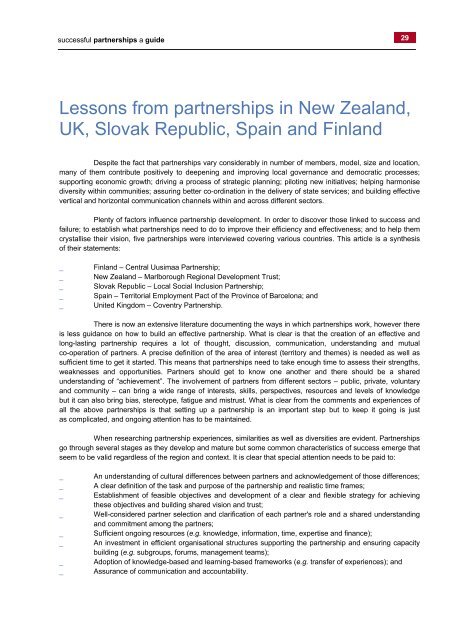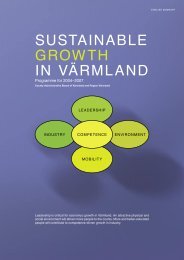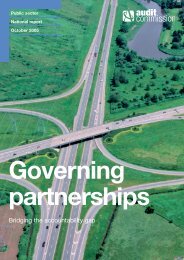successful partnerships a guide - Organisation for Economic Co ...
successful partnerships a guide - Organisation for Economic Co ...
successful partnerships a guide - Organisation for Economic Co ...
Create successful ePaper yourself
Turn your PDF publications into a flip-book with our unique Google optimized e-Paper software.
<strong>successful</strong> <strong>partnerships</strong> a <strong>guide</strong><br />
29<br />
Lessons from <strong>partnerships</strong> in New Zealand,<br />
UK, Slovak Republic, Spain and Finland<br />
Despite the fact that <strong>partnerships</strong> vary considerably in number of members, model, size and location,<br />
many of them contribute positively to deepening and improving local governance and democratic processes;<br />
supporting economic growth; driving a process of strategic planning; piloting new initiatives; helping harmonise<br />
diversity within communities; assuring better co-ordination in the delivery of state services; and building effective<br />
vertical and horizontal communication channels within and across different sectors.<br />
Plenty of factors influence partnership development. In order to discover those linked to success and<br />
failure; to establish what <strong>partnerships</strong> need to do to improve their efficiency and effectiveness; and to help them<br />
crystallise their vision, five <strong>partnerships</strong> were interviewed covering various countries. This article is a synthesis<br />
of their statements:<br />
_<br />
_<br />
_<br />
_<br />
_<br />
Finland – Central Uusimaa Partnership;<br />
New Zealand – Marlborough Regional Development Trust;<br />
Slovak Republic – Local Social Inclusion Partnership;<br />
Spain – Territorial Employment Pact of the Province of Barcelona; and<br />
United Kingdom – <strong>Co</strong>ventry Partnership.<br />
There is now an extensive literature documenting the ways in which <strong>partnerships</strong> work, however there<br />
is less guidance on how to build an effective partnership. What is clear is that the creation of an effective and<br />
long-lasting partnership requires a lot of thought, discussion, communication, understanding and mutual<br />
co-operation of partners. A precise definition of the area of interest (territory and themes) is needed as well as<br />
sufficient time to get it started. This means that <strong>partnerships</strong> need to take enough time to assess their strengths,<br />
weaknesses and opportunities. Partners should get to know one another and there should be a shared<br />
understanding of “achievement”. The involvement of partners from different sectors – public, private, voluntary<br />
and community – can bring a wide range of interests, skills, perspectives, resources and levels of knowledge<br />
but it can also bring bias, stereotype, fatigue and mistrust. What is clear from the comments and experiences of<br />
all the above <strong>partnerships</strong> is that setting up a partnership is an important step but to keep it going is just<br />
as complicated, and ongoing attention has to be maintained.<br />
When researching partnership experiences, similarities as well as diversities are evident. Partnerships<br />
go through several stages as they develop and mature but some common characteristics of success emerge that<br />
seem to be valid regardless of the region and context. It is clear that special attention needs to be paid to:<br />
_<br />
_<br />
_<br />
_<br />
_<br />
_<br />
_<br />
_<br />
An understanding of cultural differences between partners and acknowledgement of those differences;<br />
A clear definition of the task and purpose of the partnership and realistic time frames;<br />
Establishment of feasible objectives and development of a clear and flexible strategy <strong>for</strong> achieving<br />
these objectives and building shared vision and trust;<br />
Well-considered partner selection and clarification of each partner's role and a shared understanding<br />
and commitment among the partners;<br />
Sufficient ongoing resources (e.g. knowledge, in<strong>for</strong>mation, time, expertise and finance);<br />
An investment in efficient organisational structures supporting the partnership and ensuring capacity<br />
building (e.g. subgroups, <strong>for</strong>ums, management teams);<br />
Adoption of knowledge-based and learning-based frameworks (e.g. transfer of experiences); and<br />
Assurance of communication and accountability.








